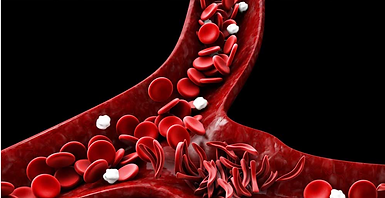
Understanding Sickle Cell Disease: Impact, Facts & Hope

What is Sickle Cell Disease (SCD?
Sickle Cell Disease (SCD) is a genetic blood disorder that affects the shape and function of red blood cells. Instead of being round and flexible, these cells become crescent-shaped ("sickled"), making it harder for them to travel through blood vessels. This can cause pain, organ damage, and other serious complications.
Approximately 100,000 people are living with sickle cell disease (SCD) in the United States and millions more globally. Current estimates indicate that about 300,000 people are born with SCD each year worldwide.
Since its discovery in 1910, SCD has received relatively little attention and few resources from the scientific, clinical, and public health communities compared with other genetic disorders, such as cystic fibrosis. Until December 2018, only one drug was approved by the U.S. Food and Drug Administration (FDA) for the condition. A contributing factor to this lack of awareness and resources is that the affected population, which is primarily composed of racial and ethnic minorities, contends with persistent discrimination in the health care system and racism in society at large. Funding for SCD has also historically been low, especially compared to federal and private funding for other conditions, and has decreased over the years.
Sickle cell disease is a lifelong illness. A blood and bone marrow transplant is currently the only cure for sickle cell disease.


How is sickle cell disease (SCD) diagnosed?
A blood test can show if you have SCD or sickle cell trait. All states now test newborns in their screening programs, so treatment can begin early.
People who are thinking about having children can have the test to find out how likely it is that their children will have SCD.
Doctors can also diagnose SCD before a baby is born. The test uses a sample of amniotic fluid (the liquid in the sac surrounding the baby) or tissue taken from the placenta (the organ that brings oxygen and nutrients to the baby).

What are the symptoms of SCD?
People with SCD start to have signs of the disease during the first year of life, usually around 5 months of age. Early symptoms of SCD may include:
-
Painful swelling of the hands and feet
-
Fatigue or fussiness from anemia
-
A yellowish color of the skin (jaundice) or the whites of the eyes (icterus)
Effects from SCD vary from person to person and can change over time. Most of the signs and symptoms of SCD are related to complications of the disease. They may include severe pain, anemia, organ damage, and infections.

Who is at risk for sickle cell disease (SCD)?
In the United States, most people with SCD are African Americans:
-
About 1 in 13 African American babies is born with sickle cell trait
-
About 1 in every 365 black children is born with sickle cell disease
SCD also affects some people who come from Hispanic, southern European, Middle Eastern, or Asian Indian backgrounds.

So what are the treatments for sickle cell disease (SCD)?
The only cure for SCD is bone marrow or stem cell transplantation. Because these transplants are risky and can have serious side effects, they are usually only used in children with severe SCD. The bone marrow must be a close match for the transplant to work. Usually, the best donor is a brother or sister.
The treatments that can help relieve symptoms, lessen complications, and prolong life:
-
Antibiotics are used to try to prevent infections in younger children
-
Pain relievers for acute or chronic pain
-
Four FDA-approved medications
-
Childhood vaccinations to prevent infections
-
Blood transfusions for severe anemia. If you have had some serious complications, such as a stroke, you may have transfusions to prevent further complications.
Researchers have developed a gene therapy that may be able to treat patients with sickle cell disease using gene editing technology. The new treatment stops the cells from expressing the mutated gene and induces the body’s cells to make fetal hemoglobin. The early signs of this are promising: one patient showed no signs of sickle-shaped blood cells. The researchers are hoping to test it in a clinical trial in people between 3 and 40 years old.
NIH: National Heart, Lung, and Blood Institute
The Impact of SCD
100K
100K
90%
300M
How Can you Help?
